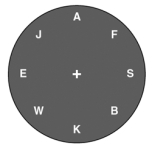Correct Answer

verified
Correct Answer
verified
Multiple Choice
Olfactory receptors are embedded in the
A) olfactory mucosa.
B) nose hairs.
C) olfactory nucleus.
D) olfactory neocortex.
E) cribriform plate.
Correct Answer

verified
Correct Answer
verified
Multiple Choice
Taste receptors typically occur in clusters of 50 to 100. These clusters are called
A) glomeruli.
B) taste buds.
C) taste receptor nuclei.
D) papillae.
E) taste mucosas.
Correct Answer

verified
Correct Answer
verified
Multiple Choice
Stare at the + sign and without moving your eyes, shift your focus from one letter to another. You have just experienced 
A) overt attention.
B) covert attention.
C) the cocktail party phenomenon.
D) bottom-up attention.
E) exogenous attention.
Correct Answer

verified
Correct Answer
verified
Short Answer
The spinothalamic, spinoreticular, and spinotectal somatosensory tracts are all part of the __________ system.
Correct Answer

verified
Correct Answer
verified
Multiple Choice
Tinnitus
A) always accompanies hearing loss.
B) is always cured by cutting the contralateral auditory nerve.
C) is always cured by cutting the ipsilateral auditory nerve.
D) both A and C
E) none of the above
Correct Answer

verified
Correct Answer
verified
Multiple Choice
The primary auditory cortex is in the
A) temporal lobe.
B) lateral fissure.
C) occipital lobe.
D) frontal lobe.
E) both A and B
Correct Answer

verified
Correct Answer
verified
Multiple Choice
Much of SII is
A) adjacent to SI.
B) in the lateral fissure.
C) in the parietal cortex.
D) all of the above
E) none of the above
Correct Answer

verified
Correct Answer
verified
Multiple Choice
The perception of pitch in primates seems to occur in
A) the thalamus.
B) one small cortical area just anterior to primary auditory cortex.
C) association cortex.
D) primary auditory cortex.
E) all areas of association cortex together.
Correct Answer

verified
Correct Answer
verified
Multiple Choice
Which of the following is part of the organ of Corti?
A) the semicircular canals
B) the hair cells
C) the basilar membrane
D) all of the above
E) both B and C
Correct Answer

verified
Correct Answer
verified
Multiple Choice
Which of the following is often associated with asomatognosia?
A) the rubber hand illusion
B) aphasia
C) anosognosia
D) all of the above
E) both A and C
Correct Answer

verified
Correct Answer
verified
Short Answer
A __________ is an area of the body that is innervated by the dorsal roots of one segment of the spinal cord.
Correct Answer

verified
Correct Answer
verified
Multiple Choice
__________ are found in __________, which are often located around small protuberances called __________.
A) Taste receptors; taste buds; papillae
B) Taste buds; taste receptors; papillae
C) Taste receptors; papillae; taste buds
D) Taste buds; papillae; taste receptors
E) Papillae; taste receptors; taste buds
Correct Answer

verified
Correct Answer
verified
Short Answer
Hearing loss is sometimes associated with __________ (ringing of the ears).
Correct Answer

verified
Correct Answer
verified
Multiple Choice
The Pacinian corpuscle is
A) the largest cutaneous receptor.
B) the most deeply positioned cutaneous receptor.
C) fast adapting.
D) all of the above
E) none of the above
Correct Answer

verified
Correct Answer
verified
Multiple Choice
Electrical stimulation of which of the following structures has analgesic effects?
A) SII
B) periaqueductal gray
C) paraventricular nuclei
D) ventral posterior nuclei
E) medial lemniscus
Correct Answer

verified
Correct Answer
verified
Multiple Choice
There seem to be five primary tastes: sweet, sour, bitter, salty, and
A) fatty.
B) umami.
C) oily.
D) mamawawa.
E) yumyumi.
Correct Answer

verified
Correct Answer
verified
Essay
Compare the anatomy of the two major ascending somatosensory pathways: the dorsal-column medial lemniscus pathway and the anterolateral pathway. Draw them. What are their functions?
Correct Answer

verified
50% for comparing the two syst...View Answer
Show Answer
Correct Answer
verified
View Answer
Multiple Choice
Selective attention
A) improves the perception of stimuli that are its focus.
B) has no effect on perception.
C) seems to depend totally on thalamic mechanisms.
D) seems to depend totally on changes in receptors.
E) blocks out, just slightly, the perception of those stimuli that are its focus.
Correct Answer

verified
Correct Answer
verified
Multiple Choice
A hierarchical system is one in which
A) there is one absolute top.
B) there is one absolute bottom.
C) each element has specific levels or ranks with respect to one another.
D) no two elements are at the same level.
E) there is no cortical involvement.
Correct Answer

verified
Correct Answer
verified
Showing 41 - 60 of 150
Related Exams